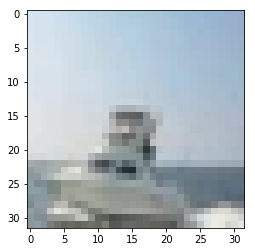1.4 数据处理与模型图构建
-
transflow 搭建 : www.tensorflow.org/install/ins…
-
使用的是cifar-10 的数据集 www.cs.toronto.edu/~kriz/cifar…
The CIFAR-10 dataset consists of 60000 32x32 colour images in 10 classes, with 6000 images per class. There are 50000 training images and 10000 test images.
CIFAR-10 下载下来的python版本文件目录结构如下
(deeplearning-0jfGJJsa) ~/project/pycharm/deeplearning/01_nn ᐅ tree cifar-10-batches-py cifar-10-batches-py ├── batches.meta ├── data_batch_1 # 一共5个batch的训练数据集,每个batch中有10000张图片和对应的数据 ├── data_batch_2 ├── data_batch_3 ├── data_batch_4 ├── data_batch_5 ├── readme.html └── test_batch # 测试数据集 0 directories, 8 files -
关于jupyternotebook修改默认环境的文章:www.jianshu.com/p/f70ea020e…
-
直观的显示一张图片
- 导入数据集
import pickle import numpy as np import os CIFAR_DIR = './cifar-10-batches-py' print(os.listdir(CIFAR_DIR))['data_batch_1', 'readme.html', 'batches.meta', 'data_batch_2', 'data_batch_5', 'test_batch', 'data_batch_4', 'data_batch_3']with open(os.path.join(CIFAR_DIR, "data_batch_1"), 'rb') as f: data = pickle.load(f, encoding='bytes') print(type(data)) print(data.keys()) print(type(data[b'data'])) print(type(data[b'labels'])) print(type(data[b'batch_label'])) print(type(data[b'filenames'])) print(data[b'data'].shape) # 32 * 32 (像素点)* 3(rbg三通道) # RR-GG-BB print(data[b'data'][0:2]) print(data[b'labels'][0:2]) print(data[b'batch_label']) print(data[b'filenames'][0:2])<class 'dict'> dict_keys([b'batch_label', b'labels', b'data', b'filenames']) <class 'numpy.ndarray'> <class 'list'> <class 'bytes'> <class 'list'> (10000, 3072) [[ 59 43 50 ... 140 84 72] [154 126 105 ... 139 142 144]] [6, 9] b'training batch 1 of 5' [b'leptodactylus_pentadactylus_s_000004.png', b'camion_s_000148.png']- 显示一张图片
image_arr = data[b'data'][100] image_arr = image_arr.reshape((3,32,32)) # 需要32,32,3 image_arr = image_arr.transpose((1,2,0)) from matplotlib.pyplot import imshow imshow(image_arr)<matplotlib.image.AxesImage at 0x12311e668>
-
模型图构建
import tensorflow as tf import pickle import numpy as np import os CIFAR_DIR = './cifar-10-batches-py' print(os.listdir(CIFAR_DIR)) def load_data(filename): """read data from data file.""" with open(filename, 'rb') as f: data = pickle.load(f, 'bytes') return data[b'data'], data[b'labels'] # placeholder 占位符,可以代表一个变量,可以用来构建计算图,有数据来的时候就把数据传入 # None 代表输入的样本数目是不确定的,3072 是变量的维度 x = tf.placeholder(tf.float32, [None, 3072]) y = tf.placeholder(tf.int64, [None]) # 只有一个维度就省略了 # get_variable 如果已经定义了则使用,否则使用指定方式定义 # 'w':变量名 # [x.get_shape()[-1],1]: 指定变量的维度 # initializer: 初始化变量的方式 w = tf.get_variable('w', [x.get_shape()[-1],1], initializer = tf.random_normal_initializer(0, 1)) b = tf.get_variable('b', [1], initializer = tf.constant_initializer(0.0)) # matmul 矩阵乘法 # x (None,3072) w (3072,1) b(3072,1) # y_ = [None,3072]*[3072,1] + [3072,1] = [None,1] y_ = tf.matmul(x, w) + b # 激活函数 (None,1) p_y_1 = tf.nn.sigmoid(y_) # (None,1) y_reshaped = tf.reshape(y, (-1,1)) y_reshaped_float = tf.cast(y_reshaped, tf.float32) loss = tf.reduce_mean(tf.square(y_reshaped_float - p_y_1)) # bool predict = p_y_1 > 0.5 # [1,0,1,1,0,0,0] correct_prediction = tf.equal(tf.cast(predict,tf.int64), y_reshaped) # 3/7 accuracy = tf.reduce_mean(tf.cast(correct_prediction,tf.float64)) with tf.name_scope('train_op'): # AdamOptimizer 是梯度下降的一个变种,minimize指定在哪个变量上做 train_op = tf.train.AdamOptimizer(1e-3).minimize(loss)